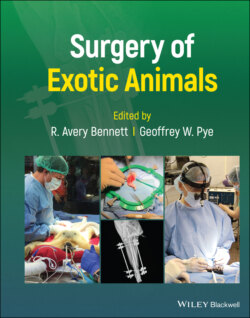Читать книгу Surgery of Exotic Animals - Группа авторов - Страница 122
Perioperative and Postoperative Considerations
ОглавлениеAmphibian surgery carries specific challenges including danger of skin desiccation, water‐soluble toxins, skin trauma, ocular lesions, thermal burns, and hyper‐ or hypothermia (Wright and Whitaker 2001a). Amphibian skin should be kept moist and should be handled gently, as it is easily damaged (Figure 6.1) and also to prevent dermatitis, xerophthalmia, and secondary osmotic imbalances (Mylniczenko 2006; Clayton and Mylniczenko 2015). Because amphibian mucus is critical for the skin’s innate immunity, limit preparation of the surgical site to avoid disrupting the natural mucous layer (Green 2010; Ramsey et al. 2010; Shigeri et al. 2015). Gently flush the skin with sterile saline or 0.05% chlorhexidine solution rather than aggressive surgical scrubbing and avoid alcohol‐based disinfectants (Poll 2009). Irrigate exposed skin with fresh chlorine‐free and chloramine‐free water throughout the surgery to avoid desiccation (Poll 2009). As a result of minimal surgical site preparation and because of the necessity for water containing appropriate electrolytes, and of the same water quality parameters as in the exhibit, achieving asepsis is challenging. Place patients over a moist nonabrasive surface such as plastic (Wright and Whitaker 2001a), a sponge covered by a plastic drape, bubble wrap, or the underside of a disposable absorbent pad. The use of towel quarter drapes is controversial in amphibians as using dry surgical drapes may disrupt the beneficial mucous coat and wet towel drapes quickly become permeable to bacteria (Green 2010). Plastic drapes are recommended and surgical procedures performed without drapes are acceptable for many Institutional Animal Care and Use Committee (IACUC) approved protocols (Green 2010). Avoid contact between the skin and the surgical drape’s adhesive surface. To keep the drape in place, use sutures or very fine staples to protect the delicate skin. For short procedures, a safe surgical water‐soluble lubricant can be used to hold the drape in place. Surgical lighting can be damaging because of the heat and light intensity from proximal lighting sources leading to desiccation and thermal burns causing ocular and skin lesions. Light‐emitting diodes (LEDs), as commonly installed on surgical loupes, should be used to minimize these effects.
Temperature should be kept within the preferred optimal temperature zone (POTZ) of the species throughout the procedure. Like reptiles, amphibians are poikilothermic, but they rarely need supplemental heat due to their lower POTZ. It is better to keep a low room temperature and to place sealed ice packs in the water to cool it.
When handling amphibians with toxin‐producing glands, the surgeon may need to wear protective eye wear as Bufo spp. can expel toxic parotidian secretions into the air (Wright 2006). The choice of gloves is important as many compounds are absorbed through amphibian skin. Gloves with talcum powder should be avoided (Wright 2006). Latex is toxic to tadpoles of some amphibian species, including common frogs (Rana temporaria) and African clawed frogs (Xenopus laevis) and may result in acute mortalities (Sobotka and Rahwan 1994; Gutleb et al. 2001). Nitrile gloves have been shown to kill chytrid fungi zoospores that can infect amphibian patients, while polyethylene gloves did not (Mendez et al. 2008). Powderless vinyl gloves are preferred by many practitioners (Norton et al. 2014).
Figure 6.1 A wound on the lateral aspect of the tarsus in a laboratory African clawed frog (Xenopus laevis) showing granulation tissue and formation of scar tissue around the outer edge of the lesion.
Source: Photo courtesy: Companion Avian and Exotic Pet Medicine Service, University of California, Davis.
Like in other animals, perioperative antibiotics (Wright and Whitaker 2001a) and antinociception (Weber 2011) have been advocated. Antibiotics with a spectrum oriented toward Gram‐negative bacteria are preferred given the predominance of Gram‐negative bacteria in amphibian flora (Roth et al. 2013). Depending on the amphibian species, intravenous injections may be performed using the femoral vein, musculocutaneous vein (Sancho et al. 2012), popliteal plexus, ventral abdominal vein, or lingual venous plexus in frogs larger than 25 g (Whitaker and Wright 2001) (Figure 6.2). Alternatively, preoperative antibiotics may be administered topically (ciprofloxacin 10 mg/kg; Wright and Whitaker 2001b), subcutaneously (enrofloxacin 10 mg/kg; Wright and Whitaker 2001b) or intramuscularly (amikacin 5 mg/kg: Felt et al. 2013), or into the dorsal lymphatic sacs that are paired sacs accessible dorsally on each side of the urostyle.
Amphibian opioid receptors are similar to those of mammals (Newman et al. 2002). Amphibians appear to require higher doses of opioids to produce antinociception when compared to rodents (Koeller 2009). Opioid dosages up to hundred times the minimal dose have been reported for northern leopard frogs (Stevens 2011). Recommended opioid dosages need to be refined in amphibians. The reader is referred to review chapters about amphibian anesthesia regarding monitoring and choice of anesthetic agents (Mitchell 2009; Braitman and Stetter 2014; O'Rourke and Jenkins 2014).
Figure 6.2 Possible intravenous injection sites in amphibians.
Source: Delphine Grosset, Visual Conception Communication Creator.
Anurans may be more resistant to the effects of hemorrhage than some mammals (Chai 2015a) due to lymph regulation and a powerful baroreceptor reflex (Hedrick et al. 2015) as long as they are maintained at their POTZ of the species (Zena et al. 2015). Hemostasis can be accomplished using techniques similar to those employed in mammals, and some authors have also recommended using cyanoacrylate tissue adhesive as an hemostatic agent for internal organs (Wright and Whitaker 2001a), but no study has investigated adverse effects associated with this technique.
Patients with skin sutures may be kept isolated in a tank with a nonabrasive substrate such as a moist plastic lining. In aquatic species, water quality should be carefully monitored during the postoperative period, especially in patients with incisional secretions that may increase nitrogenous wastes in the tank water. Skin sutures may be removed after about three weeks (Green 2010). Similar to other patients, nutritional support and postoperative antinociceptive drugs may be needed depending on the procedure performed (Gentz 2007).
